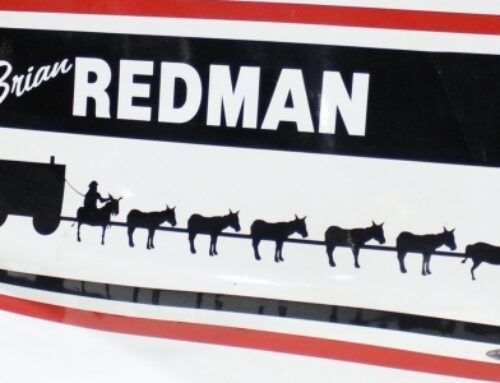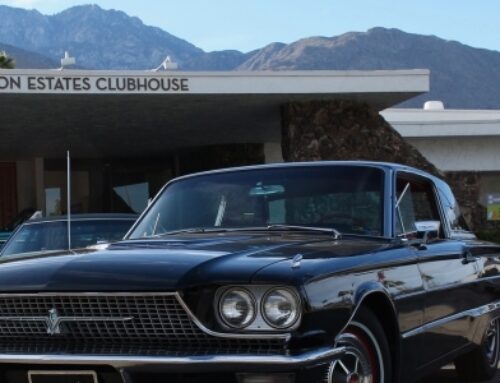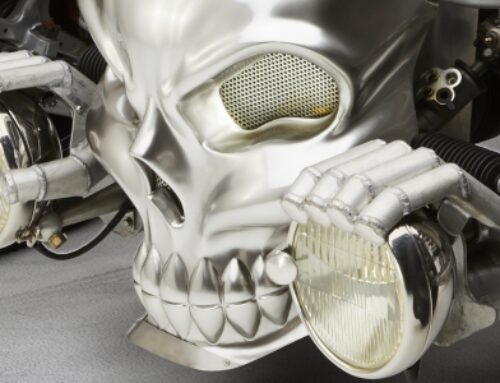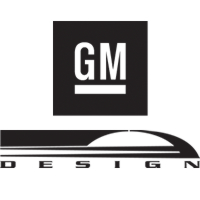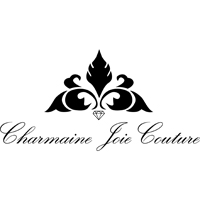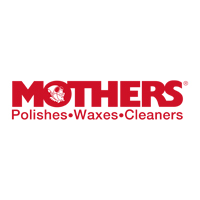A defining feature of many mid-century cars are the proportions. The term “land yacht” does capture the essence of many wheeled dinosaurs that lived and survived beyond the Kennedy administration. Lo and behold, this was also the brand name of a travel trailer during that decade. The Modernism Week Vintage Trailer Show does feature that manufacturer and several other period brands, as well as a vast assortment of models and styles. This regularly featured event, just one of over 400 events under the Modernism Week umbrella, brings in much more than just homes on wheels, it brings together people with a passion for the period.
Article and images © John Grafman
To be clear, these are trailers, so no motors or driving components are involved. This is the secret sauce as to why these are popular to resurrect, restore, and modify. The complexity can be minimal depending on the model. For some, these become DIY projects. The smallest of these do without such niceties like bathrooms, a kitchenette, and plumbing. On the other hand, the larger models include those and offer other features, with everything from bedrooms to bars. It’s a handyman’s dream.
Toby Figueroa and Marsha Horry of Orange County Vintage Trailers are pointing out that the vintage trailers can capture our imagination with period appeal. They are telling us that this includes the use of, “real birch and other natural woods that bring a warmth to the interiors that new, modern trailers don’t have. The colors and patterns used on countertops and curtains bring fun and brightness to the interiors. The use of aluminum for trims and accents has shine and longevity that the replacement of plastics can’t mimic. Additionally, there is the timelessness of Marmoleum sheet vinyl flooring from the 1940s is still used in trailers today with colors and patterns reminiscent of yesteryears and new, bold designs as well.”
Vintage Trailers: Original Or Modified
“Few trailers have survived the years without some modifications thus intact functional originals are rare and have significant appeal,” according to Brad Taylor, Show Producer, at Shiny Shacks. “Most vintage trailers require repair or restoration when first brought back into use. In the restoration and repair process modifications and upgrades are often made. These changes are done for functionality and safety. Amongst the vintage trailer community personalization or modification to interiors is common and acceptable. The general rule is to not alter the exterior aesthetic.
“Trailer owners will often select a theme to decorate or design their trailers around. The Seattle World’s Fair, Tiki bar, Desi & Lucy, and rustic cabin are common themes.” As Brad Taylor is also the producer, man-in-charge of the Vintage Trailer Show at Modernism Week and assisted the production for a decade. It’s fair to say that he’s seen it all and loves it.
Bread Loafs, Silver Twinkies, Canned Hams
The era spawned various iterations of the proper accommodations for Americans on the move. Numerous factors were in play. Just as plentiful were the names used to reference each layout. Fortunately, Taylor is able to decode these nicknames. He informs the novices to this form of transportation, “There are a few basic styles of vintage trailers; Tear Drops, Pop Ups, Bread Loafs, Silver Twinkies, Canned Hams, and Eggs. These styles are largely named for the profile appearance of the trailers. Tear Drop trailers are smaller 2 person trailers that typically have just enough room for a bed, no room to stand in, and a kitchen accessed via a rear hatch. Pop Up trailers come in various sizes with both hard and soft sides that compress down for transport. Bread Loaf trailers are boxy looking, the common style of the 30s and 40s. Silver Twinkies are unpainted aluminum skinned trailers (like Airstreams). Canned Hams are the rather oval shaped trailers introduced in the 50s and popular throughout the 60s. Eggs are smaller Fiberglas trailers introduced in the 60s. There are a few trailers that fall outside of these classifications.”
Toby and Marsha also mention, “Most trailers from the 50’s and 60’s use vibrant colors that are very reminiscent of MCM with the use of turquoise, pink, yellow, both inside and out, whether original or restored. Even in current times, camper owners enjoy keeping the vibe and feel of how their trailer once was decades ago.”
Creativity Can Rule The Day
This is really where creativity can rule the day and capture the style of the owner. All ends of the spectrum are explored with some very raw examples that showcase a patina that’s been brewing for years. Other owners at the Vintage Trailer Show have opted to make their home on wheels better than new. We concur with Brad Taylor, Toby Figueroa, and Marsha Horry in that the polish jobs rival the best with mirror-like reflections. The woodwork in numerous models looks flawless and shows a like-new finish. From the linoleum flooring to the aluminum ceiling, the surfaces have been lovingly treated. Interior colors and materials can express even more, as the options are almost limitless.
One universal truth throughout the mid-century period was the “C” word… Chrome! There’s something to be learned from this. People love shiny objects. But like anything else, too much of a good thing isn’t necessarily good. Restraint keeps chrome from becoming chaos. The pendulum does swing both ways. The usage has gone from over the top on vintage scooters, cars, and travel trailers to almost invisible on today’s machines. And being the responsible adults that we are, environmental concerns are definitely one factor that comes into play, which wasn’t nearly the issue or concern fifty years ago that it is today. Nevertheless, the public loves anything bright, sparkly, and reminds them of the open roads and unlimited possibilities.
Demand Far Exceeds Supply
“In many ways interest in vintage trailers is similar to that of vintage cars. Although related to [motor] vehicles, the largest deviation between the vintage cars and trailers comes down to availability. The automotive industry was dominated by a small number of manufacturers producing a large number of vehicles annually,” is pointed out by Taylor. But there’s more to the story and Taylor continues, “The trailer industry by comparison had a multitude of manufacturers, many in business for short periods, producing a relatively small quantity of trailers. A good example of this is found in 1953. That year Ford Motor Company produced 1,200,000 cars whereas Airstream, a larger manufacturer, produced less than 750 trailers. When these trailers were produced in the 30s, 40s, 50s, and 60s no one expected them to be in use 60 years later. Low production rates coupled with low survival rates makes finding good trailers difficult. This has produced a situation in which demand far exceeds supply.”
Now, we’d all like to think this fascination with mid-century modern homes, vintages cars, scooters, trailers, furniture, art and more will roll along forever. And, with an estimate of more than 130,000 attendees at Modernism Week 2024, generating an economic impact of over $68 million to the local area, who are we to argue. However, Jeff Stork is a bit more perceptive than the average person. Stork honestly says, “I think this era is to some degree a closing window. People tend to collect the cars they saw and drove in their youth, and as fewer people can relate to the era firsthand, demand will change. These won’t suddenly be headed into exile, but prices will soften as younger collectors gravitate to the cars of their own childhoods.”
Fewer People Can Relate To The Era Firsthand
Will these influential artifacts from the mid-century that are inhabiting Modernism Week continue to be as loved tomorrow as these are today? Well, as the saying goes, time will tell.
Find out more about the vintage cars and scooters of Modernism Week 2024

























